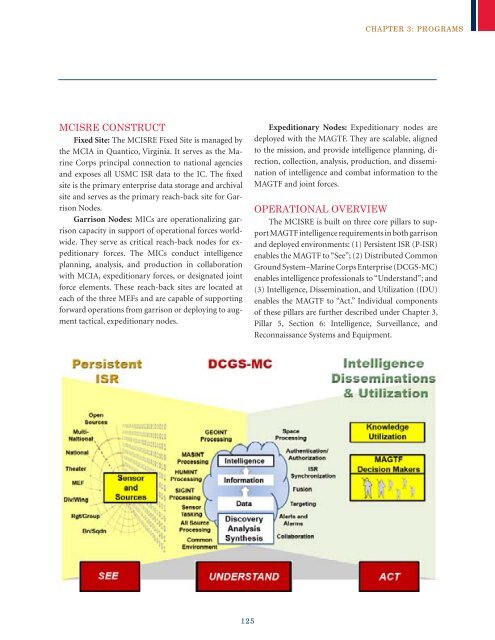USMC Concepts & Programs 2013 - Defense Innovation Marketplace
USMC Concepts & Programs 2013 - Defense Innovation Marketplace
USMC Concepts & Programs 2013 - Defense Innovation Marketplace
You also want an ePaper? Increase the reach of your titles
YUMPU automatically turns print PDFs into web optimized ePapers that Google loves.
chapter 3: programs<br />
MCISRE Construct<br />
Fixed Site: The MCISRE Fixed Site is managed by<br />
the MCIA in Quantico, Virginia. It serves as the Marine<br />
Corps principal connection to national agencies<br />
and exposes all <strong>USMC</strong> ISR data to the IC. The fixed<br />
site is the primary enterprise data storage and archival<br />
site and serves as the primary reach-back site for Garrison<br />
Nodes.<br />
Garrison Nodes: MICs are operationalizing garrison<br />
capacity in support of operational forces worldwide.<br />
They serve as critical reach-back nodes for expeditionary<br />
forces. The MICs conduct intelligence<br />
planning, analysis, and production in collaboration<br />
with MCIA, expeditionary forces, or designated joint<br />
force elements. These reach-back sites are located at<br />
each of the three MEFs and are capable of supporting<br />
forward operations from garrison or deploying to augment<br />
tactical, expeditionary nodes.<br />
Expeditionary Nodes: Expeditionary nodes are<br />
deployed with the MAGTF. They are scalable, aligned<br />
to the mission, and provide intelligence planning, direction,<br />
collection, analysis, production, and dissemination<br />
of intelligence and combat information to the<br />
MAGTF and joint forces.<br />
Operational Overview<br />
The MCISRE is built on three core pillars to support<br />
MAGTF intelligence requirements in both garrison<br />
and deployed environments: (1) Persistent ISR (P-ISR)<br />
enables the MAGTF to “See”; (2) Distributed Common<br />
Ground System–Marine Corps Enterprise (DCGS-MC)<br />
enables intelligence professionals to “Understand”; and<br />
(3) Intelligence, Dissemination, and Utilization (IDU)<br />
enables the MAGTF to “Act.” Individual components<br />
of these pillars are further described under Chapter 3,<br />
Pillar 5, Section 6: Intelligence, Surveillance, and<br />
Reconnaissance Systems and Equipment.<br />
125

















